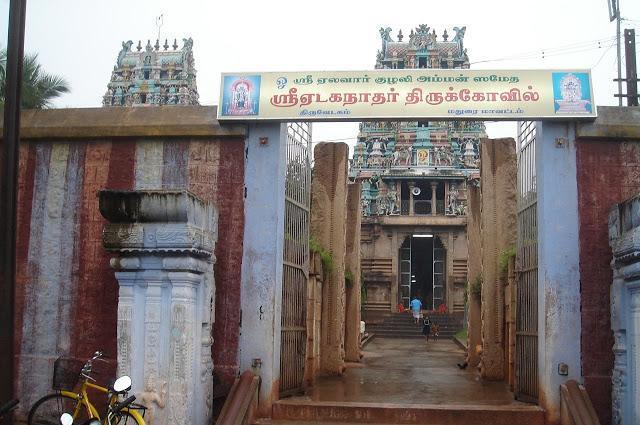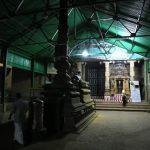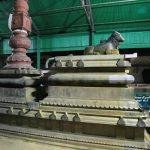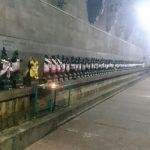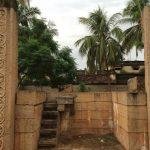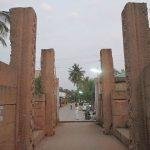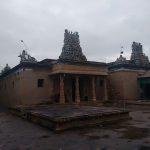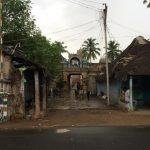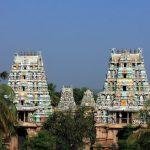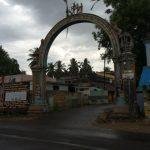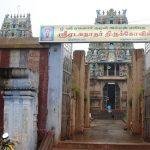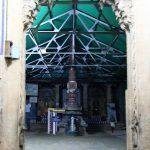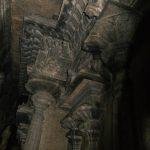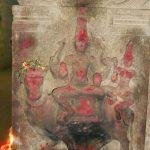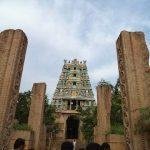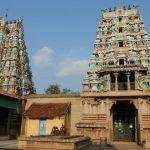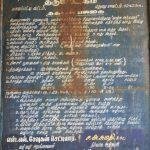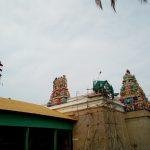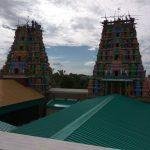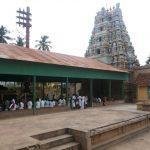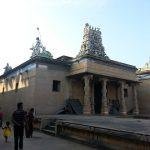Contents
Edaganathar Temple, Thiruvedagam, Madurai
| Date built: | – |
|---|---|
| Deity: | Edaganathar, Shiva |
| Architectural style: | Dravidian architecture |
| Major festivals | – |
| Locale: | Thiruvedagam |
| District:: | Madurai |
| Address: | Edaganathar Temple,Thiruvedagam – 624 234, Vadipatti Taluk, Madurai District, |
| Phone | +91 4543 259 311 / +91 99432 61487 |
The original complex is believed to have been built by Pandyan Empire, while the present masonry structure was built during the Nayak during the 16th century. In modern times, the temple is maintained and administered by the Hindu Religious and Charitable Endowments Department of the Government of Tamil Nadu. This temple is erected to commemorate the victory of Saivites over Jains and to emphasis that Shiva is the greatest God of all. The temple has six daily rituals at various times from 6:00 a.m. to 8:30 p.m. and four yearly festivals on its calendar. The Muthu Pandal festival is celebrated during the day of the Magam (February – March) is the most prominent festival.
The presiding deity is revered in the 7th century Tamil Saiva canonical work, the Thevaram, written by Tamil saint poets known as the Nayanmars and classified as Paadal Petra Sthalam. The temple is closely linked with the history of Saivite Child Saint Thirugnana Sambandar and is praised in his Thevaram hymns. This is the 248th Devara Padal Petra Shiva Sthalam on the banks of river Vaigai and 4th Sthalam of Pandya Naadu. Thirupugazh, the work of Arunagirinathar, a 13th-century saint glorifies the temple.
Temple Opening Time
The temple is open from 6.30 a.m. to 12.00 a.m. and from 4.30 p.m. to 8.00 p.m.
Prayers
As people perform remedial prayers and pujas in Tirumananjeri for removal of obstacles in marriage efforts, devotees do it in this temple also. They offer garlands to Mother Elavarkuzhali and take to their homes. They worship the garland and perform pujas for 48 days to realize the wedding wish. After marriage, couple come to the temple and offer prayers to Ambica. Devotees offer vastras to Lord and Mother and contribute for the renovation of the temple.
Festivals
The temple priests perform the puja (rituals) during festivals and on a daily basis. The temple rituals are performed six times a day; Kalasanthi at 6:00 a.m., Irandam Kalm at 9:00 a.m., Uchikalam at 12:00 a.m., Sayarakshai at 6:00 p.m, Irandam Kalm at 7:30 p.m., and Arthajamam at 9:00 p.m. Each ritual comprises four steps: abhisheka (sacred bath), Alangaram (decoration), neivethanam (food offering) and Deepa aradanai (waving of lamps) for Edaganathar and Elavarkuzhali. There are weekly rituals like Somavaram (Monday) and Sukravaram (Friday), fortnightly rituals like Pradosham, and monthly festivals like Ammavasai (new moon day), kiruthigai, Pournami (full moon day) and Sathurthi.
Sambandar’s miracle is celebrated every year as Edu Ethireriya Utsavam remembering the event of the palm leaf of Gnanasambandhar floating against the current of Vaigai River on Aavani Avittam Star day combined with full moon day during the Tamil month of Vaikasi. Sankabisheka, performed during Karthikai (November – December) is considered very sacred in the region. The Muthu Pandal festival is celebrated during the day of the Magam (February – March) is the most prominent festival.
Chithirai Tamil New Year day falling almost on April 14 or a day before or after occasionally in some year; Vaikasi Visakam in May-June; Lord Nataraja Tirumanjanam on Aani Uthiram in June-July; Special abishek to Ambica (Poopunitha Neerattu) on Aadi Pooram day in July-August; Karthikai Deepam in November-December; Margazhi Arudra darshan in December-January, Masi Float festival in February-March and Panguni Uthiram in March-April are the festivals celebrated in the temple.
There is a festival in the temple almost each month for a day only. Only Navarathri is celebrated for 10 days. Though there is a flag post – Kodimaram in Tamil – Brahmmotsavam is not celebrated in the Temple except an abishek to the post in Chithirai first day-Tamil new year day when Panchanga-almanac is read out. For Mahasivarathri puja, the fourth puja of the night is dedicated to Bhairava, unlike in most other temples where all pujas are for Siva.
Architecture
Legend / Local stories
Thiruvedagam:
Pandya kingdom with its capital at Madurai was under the rule of Koon Pandian (hunchback Pandiyan) then. Those were the days when Jainism was dominant in the kingdom with political support – king’s support. Saivism and Shiva worship were almost routed out. Child Saivite Saint visited the city in such a situation. This created a fear in the minds of the Jain monks. They set fire in the camp of the saint to eliminate him. Knowing their evil design, Gnanasambandhar sung 10 verses directing the fire on the king who was their support then. The effective verses had their impact on the king affecting him with severe burning small pox boils in the whole body.
The Jain monks did their best with the mantras they knew, but in vain. The king appealed to people to help him in his distress. All merciful Gnanasambandhar came to his palace, sung a Pathigam-10 verses- beginning with line “Mandhiram Avathu Neeru” meaning the best Mantra is the sacred ash on the Body of Lord Shiva, brought the ashes from the kitchen of Mother Meenakshi Amman temple and applied it on the body of the king. The small pox disappeared miraculously immediately even with any of symptoms. King began to think of the glory of Saivism.
The Jains, shaken by the incident said that it was witchcraft work of the saint and challenged him to a contest and vowed that they would leave Madurai if defeated. The contest was that both will write a verse and place it on the floods of Vaigai River. The victor will be the one whose song leaf swims against the current and reaches the banks. If lost in the current, they will be the loser. Jains wrote the verse beginning with the lines Athi Nathi. Sambandars’ verse began with “Vazhga Andanar, Vanavar Aaninam”. Jains leaf was washed away. Sambandar continued his song Vanniyum Mathamum and the verse leaf reached the shores establishing the Might and Glory of Lord Shiva.
Yedu in Tamil means the palm leaf used for writing in those days. The place where the Yedu reached the shore came to be known as Thiruvedagam. Vaaduvenra Vinayakar here is said to have stopped the movement of the palm leaf in the guise of a fish, in response to Sambandar’s patikam. The palmyra leaf which the Samanars left was swept away by the river and reached ‘Thirupasethi’ (Thiru + pa + Serthal) later to be known as Thirupachetty.
Sattainathar Adhishtanam:
There is still a controversy about the place where Sattainathar Siddha attained Samadhi. Seven places claim this honour. During his visit to Thiruvedagam, he saw Shivalingas scattered on the way and was afraid to tread on the way. Boys in the place use to simply carry him to the temple. He changed the river sands into some useful things and offered them to the boys. Sattainathar and his followers used to put the sacred ash in the water soaked rice (Neeraharam in Tamil) and cured stomach aches. Following this example, even today people use to bring the water soaked Neeraharam to the Sattainathar Adhishtana (Samadhi), place it on the Linga there and consume it for stomach problems. On the new moon day in the month of Aadi – Aadi Amavasya in July – August, Guru Puja is dedicated to Siddha.
Seshanur:
As per local legend, the place was called Seshanur as Adisesha, the serpent snake of Vishnu worshipped Shiva and later went on the become Edakam.
People worshipped Lord Shiva here:
Shiva here is believed to have been worshipped by Garuda, Adhiseshan and Vishnu.
Photo Gallery
How to Reach:
Edaganathar Temple is located at Thiruvedagam on the banks of the river Vaigai to the North-West of Madurai. The Temple is located at about 20 Kms from Madurai, 24 Kms from Thiruparankundram, 20 Kms from Meenakshi Amman Temple, 5 Kms from Sholavandan, 17 Kms from Vadipatti and 28 Kms from Thirumangalam.
By Road:
Thiruvedagam Temple located on the Madurai – Sholavandan bus route on the banks of the river Vaigai. Town buses are conveniently available from Madurai Central Bus Stand. Buses to Sholavandan go via Thiruvedagam and the temple is very near the Thiruvedagam Bus Stop. The Temple is located at about 22 Kms from Madurai Central Periyar Bus Stand, 16 Kms from Vadipatti Bus Stand and 24 Kms from Mattuthavani Integrated Bus Terminus.
By City Bus:
- Bus No. 63, 68, 54, 29A, 29LSS – from Madurai Periyar Bus stand
- Bus No. 93 – from Madurai Mattuthavani Bus stand
- Bus No. 4 – from Thirumangalam, Madurai
By Long Route Buses:
- Madurai to Nilakottai (TNSTC) Bus stops at Thiruvedagam.
By Train:
Sholavandan Railway Station is the nearest Railway Station. It is located at about 5 Kms from the Temple. Devotees must take a bus to reach Thiruvedagam from Sholavandan Railway Station. Express trains do not stop in Sholavandan, except the Nellai Express (Train number: 2631/2632) and Mysore Express (Train number: 6731/6732) which stop at Sholavandan on both directions. Madurai Railway Station is the nearest Major Railway Station located at about 20 Kms from the Temple.
By Air:
Madurai International Airport is the nearest Airport located at about 30 Kms from the Temple.
Contact Details
Edaganathar Temple,
Thiruvedagam – 624 234,
Vadipatti Taluk, Madurai District,
Phone: +91 4543 259 311
Mobile: +91 99432 61487
Email: [email protected]
Web: thiruvedagamedaganaathar.tinfo.in

